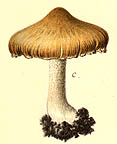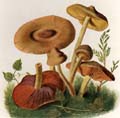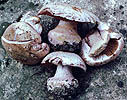 Key to Gilled Mushrooms Key
Key to Gilled Mushrooms KeyThis is a key to gilled mushrooms, that is, mushrooms having a definite cap with a fertile surface consisting of gills. The fruiting body usually also has a stem, although that may be lateral or absent (usually, then, the mushroom is growing from wood). You can use this key to identify mushrooms that you find.
 Agaricales Order
Agaricales OrderFruiting body containing fibers (usually in the stalk)
 Brown, Olive, Orange or Tan Spored Suborder
Brown, Olive, Orange or Tan Spored SuborderGills not free
Spore print tan, orange, deep ochre, yellowish olive, olive brown, rusty or cinnamon brown or deep brown
Ring usually either absent or not membranous
 Terrestrial Brown Spored Family
Terrestrial Brown Spored FamilyGrowing on the ground
 Cortinarius Genus
Cortinarius GenusWith a cobwebby partial veil called a cortina
Stem often much wider at the base
Spore print usually rusty brown or cinnamon brown
 Sericeocybe Subgenus
Sericeocybe SubgenusNot sticky anywhere
Cap not hygrophanous
Fruiting body with purple to lilac coloration
Silvery Lilac Sericeocybe Section

Diagnosis
- Entire fruiting body silvery lilac
-
Flesh white to pale lilac, not mottled
-
Gills usually purple, until colored rusty brown by developing spores
Narrow down your identification:
 Cortinarius alboviolaceus
Cortinarius alboviolaceusCap up to 2 1/2" across
Gills purple until colored rusty brown by developing spores
Stalk gradually widening to a clublike base, sheathed with thin white universal veil material (only a few patches remaining in the picture)
Growing with any trees, but favoring beech and oak
Cortinarius argentatusCap up to 2 1/2" across
Gills purple until colored rusty brown by developing spores
Stalk gradually widening to a clublike base, but lacking the universal veil material
 Cortinarius obliquus
Cortinarius obliquusCap up to 2 1/2" across
Gills purple until colored rusty brown by developing spores
Stalk abruptly widening to a clublike base, free of universal veil material






 Key to Gilled Mushrooms Key
Key to Gilled Mushrooms Key Agaricales Order
Agaricales Order Brown, Olive, Orange or Tan Spored Suborder
Brown, Olive, Orange or Tan Spored Suborder Terrestrial Brown Spored Family
Terrestrial Brown Spored Family Sericeocybe Subgenus
Sericeocybe Subgenus
 Cortinarius alboviolaceus
Cortinarius alboviolaceus Cortinarius obliquus
Cortinarius obliquus




